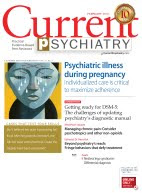Kathryn A. Roecklein, PhD, Assistant professor of psychology, The University of Pittsburgh, Pittsburgh, PA
Kelly J. Rohan, PhD, Associate professor of psychology, University of Vermont, Burlington, VT
Teodor T. Postolache, MD, Associate professor of psychiatry, Director, Mood and Anxiety Program, University of Maryland School of Medicine, Baltimore, MD
Seasonal affective disorder (SAD) is an umbrella term for mood disorders that follow a seasonal pattern of recurrence. Bipolar I disorder (BD I) or bipolar II disorder (BD II) with seasonal pattern (BD SP) is the DSM-IV-TR diagnosis for persons with depressive episodes in the fall or winter and mania (BD I) or hypomania (BD II) in spring or summer.
This article compares BD SP with major depressive disorder with seasonal pattern (MDD SP), in which depressive episodes usually occur in fall or winter and fully remit in spring or summer. Rather than being categorically distinct from each other, BD SP and MDD SP may represent extreme variants on a seasonal depression continuum from unipolar to bipolar.
Read full text (free access)
Comment on this article
Email the editor


I believe that treatment for the SAD should be rather personal, as, otherwise, it won't be effective enough. Personally I've found methods suitable for me:
ReplyDeleteSAD